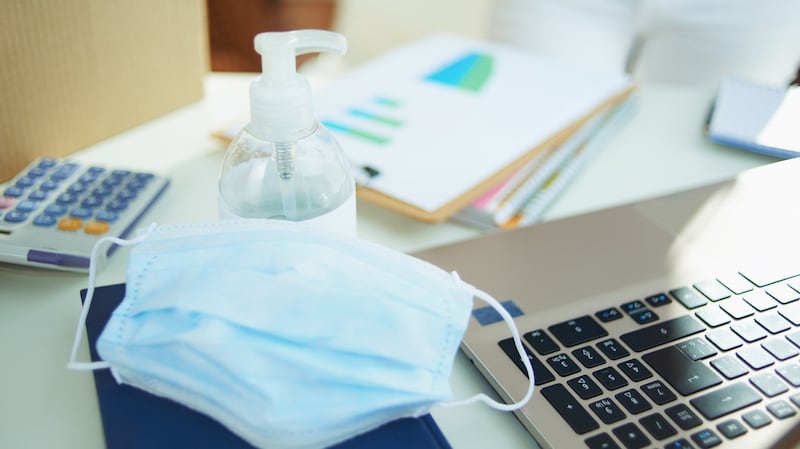Twitter grabbed the headlines this week, telling employees that where possible those who wanted to do so could continue to work from home “forever”.
But what is the likely timescale for reopening of offices in Ireland and what can employees expect when they do? All the signs are that the return for many to office life will be delayed –probably to 2021 for many – and things will look very different when they do. And the Government plan is not entirely clear on who can open, and when.
1. The Government plan


The reopening plan for the economy suggests many office employees could remain working from home beyond the final phase of the document, phase five, which is due to start on August 10th.
By then many businesses will be open but the document states that as of that date, “remote working continues for all workers or businesses that can do so.” In light of this, many bigger companies are indicating to employees that many of them will have the option of working from home at least until September/October – and possibly longer.
Public service offices – beyond essential services which have remained open throughout– will not generally reopen until August at the earliest and many employees are likely to be told to work from home if possible until much later in the year, or into 2021. Where open, offices will have fewer staff present.
There are exceptions. Some office employees cannot operate from home at all – and in many cases work now being done at home would be conducted more effectively in an office setting. The phase five plan does refer to “a phased return to work for all sectors” and while the phrase “ to work” is ambiguous, it would appear unlikely that employers who want to get employees back into an office setting would not be able to at that stage.
After all, in that final phase companies which cannot maintain social distancing at all times – such as some manufacturers, presumably – will be reopened, as well the like of tattoo artists, and pubs. Hotels will already be open from phase four, three weeks earlier, as will hairdressers and most of retail Ireland.
Is there scope for offices to open earlier than phase five?
"There is a genuine difficulty for businesses in deciding which phase under the roadmap they fit, as the definition under the economic activity for businesses who might fit under phase two or three are ambiguous," says Jennifer Cashman, partner at Ronan Daly Jermyn solicitors and an employment law expert.
For example, phase two, on June 8th, allows for the reopening of premises for “workers, like those who work on their own, as well as other workers who can keep a two-metre distance from others.”
This could be interpreted as the reopening of smaller offices or for larger premises with limited staff numbers. But the advice does add that those who can work from home should still be doing so.
Then for phase three on June 29th, the advice says that work can reopen for “people who can work safely while maintaining a two-metre distance from others”. Also, “organisations can open where employees have low levels of daily interaction with people.” This would probably give the go ahead for some more offices to return. But again the remote working where possible line is included.This may in part be designed to keep pressure off public transport for as long as possible. It also means that the pubic service will in general continue to work from home where possible beyond that date.
But more clarity will be needed on this schedule for employers and their employees in the weeks ahead.
2. What employers will do
Some companies will need to get their employees back in the office to operate properly. Others will want to. But all the signs are that most are taking a cautious approach. Many are giving their employees flexibility where possible to continue to work from home into the autumn at least and in many cases longer – Microsoft has given employees who can do so the option to work from home until the end of October and Facebook and Google internationally have told employees they can work remotely until the end of the year.
One major Irish employer this week said that his company would take a policy of allowing anyone who wanted to work from home to continue to do so for the foreseeable future, provided their job could be done that way. He said he did not expect company offices to be more than 40 per cent full until a vaccine was available, even if that took a few years. His company is actively rolling out trials of working from home in new areas.
Companies will be aware of the government guidance to continue working from home where possible beyond August. And also of their legal responsibilities to provide a safe workplace – and even the risk of legal action if they are seen to open employees to unnecessary risks.
They will also appreciate the significant costs and organisation which the return to work protocols will entail and the likelihood that not all employees will be able to return at once, as most office settings would not then be able to offer the appropriate social distancing. Confronted with all this, many are likely to opt for an extended period when people work from home at least some of the time – and in some cases all the time where possible. The question is when to start a gradual return to office life and who to involve in this first phase.
3. Childcare
There is one other key factor which will slow the return of employees in all sectors, including the office. Creche and childcare facilities for all but essential employees are not due to reopen until phase four – which is July 20th. This will clearly cause difficulties for many parents in returning to the workplace. Even when these services do reopen, the plan says that they will do so on a phased basis, possibly starting on only a day or two a week. It is not clear how quickly full child-minding services might be resumed. With uncertainty over the pace at which schools will reopen in September as well, this is a significant issue in getting the economy reopened. The Taoiseach Leo Varadkar suggested on Wednesday that he believed there was a possibility that schools and childcare facilities could open earlier – based on new research – though chief medical officer Dr Tony Holohan appeared to throw cold water on the idea.
4. What will your office be like?
Very different. Under the safety protocol, before you return you will be asked to complete a questionnaire, to verify you do not have symptoms, have not been diagnosed with Covid-19, are not a contact of someone who is a confirmed or suspected case and have not been told by a doctor to self-isolate or cocoon. As you return your employer will have to provide an induction course to ensure you are familiar with its Covid-19 policies and procedures . One employee – or more in bigger organisations – must be designated to be centrally involved with management in ensuring Covid-19 protocols are adhered to.
Your induction course will tell you of a risk assessment your employer will have conducted and what measures it has decided on.You will see prominent signs on public health advice and get regular communications as this advice evolves. You will be told of a room where anyone with Covid-19 symptoms will be taken to isolate and obligations to tell management if you start to feel ill at work. A strict process will be established to deal with such cases.
Physical distancing will be a big issue – you may well be asked to rotate in and out of the office as you and your colleagues are broken into different teams to ensure the office is never too busy. The office space may be rearranged – there may be a one-way flow around the office to avoid people passing each other and you will be told not to visit other floors or parts of the office unless this is essential. Meetings will generally be virtual. If you do attend one, or are working in a small group, your employer will keep a log of this. Wider physical meetings involving outsiders will be rare.
Canteens will be spaced out, or closed and sharing any cups in canteens, or pens with colleagues, will be a no-no. Cleaning will be stepped up and “touch points “ or queues on entry and exit will be avoided where possible.
There are two particularly awkward areas. One is “vulnerable” employees where employers are advised to “ take into account worker’s individual risk factors” . The protocol mentions older workers and those with underlying medical conditions, though has no further details. It says these people should be “enabled” to work from home if possible and that if they must attend employers must ensure “they are preferentially supported to maintain a physical distance of 2 metres.” How such employees are defined and how those who cannot work from home are supported will be a significant issues for employers to consider.
The other area is temperature testing. The protocol says companies should “implement temperature testing in line with public health advice.” It also says employees must agree to this. However as Cashman of Ronan Daly Jermyn points out, there is no existing Irish public health advice to undertake temperature check. Some employers, however, are already undertaking such checks each day – Supermac’s, for example, announced that it would do so for employees arriving each day when it reopened a takeaway service.
Given all these complexities and questions it is perhaps no surprise that many offices will be slow to reopen, except for those who have to be present.












